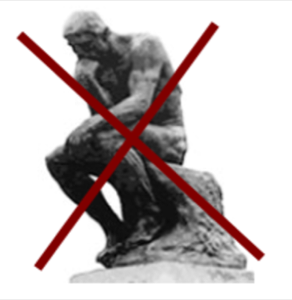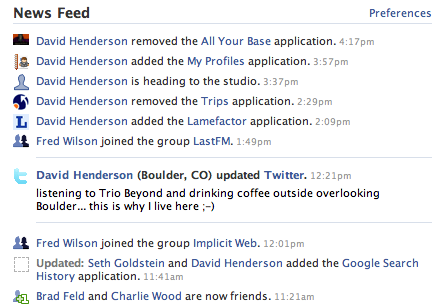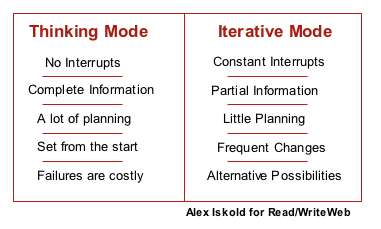The ways in which we consume and pay
attention to information are changing. The changes are not minor, they are big and
profound. Right now, it impacts us all individually – but soon the change will be visible
on a global scale. We are splitting our attention over a rapidly growing body of online
information.

To cope with that we replaced reading with skimming and learned to work in an
environment with constant interrupts. We no longer have time to pause and reflect, let
along think for a while.
Today we have successfully replaced attention with what Linda Stone coined and
Marc Orchant recently wrote about:
Continuous Partial Attention. So are we making a mistake by stretching our attention
thin? Not necessarily, it is just a new way of doing things that we have to adapt to.
This new way demands more from us – and from the software that helps us. Last week, in
the Implicit
Web post, we discussed how software can be used to automatically capture and leverage
our attention. In this post we will focus on the human impact of attention. How do
we, and people around us, adapt to this new, attention hungry world?
The Roots of Partial Attention
There are two major axis that cause inattention – the amount of information and the
interrupts. The massive adoption of broadband gave birth to new media types; like photos,
podcasts and video. The blogosphere and the social web amplified and remixed this new
content in a huge number of ways. As a result, the amount of new information has exploded
in recent years.

Consider one simple example – a Facebook profile. It is a continuos stream of activity
about all of your friends. I have maybe 30 friends on Facebook and there is quite a lot
going on each hour. My sister probably has over 200 and I cannot imagine what it is like
seeing 7 times as much activity there. For an individual to keep up with the whole
network is hard. Watching the world is interesting, but it is also exhausting. A lot of
raw, unfiltered information is what leads to partial attention.
The second cause is the interrupts. Email and chat have migrated from laptops to
wireless devices, making us all reachable anywhere anytime. If you have an engaging
business and personal life, the chances are you will be interrupted at least once an hour
and maybe even every 15 minutes. Because of these unexpected interrupts, you cannot fully
immerse yourself into your work – you can only give it your partial attention.
Iteration – the New Way We Work
We all hate the feeling of being woken up just when we are about to fall asleep.
Because we cannot fully dive into problems, we are learning to not dive at all. Instead,
we solve problems iteratively. We do not map out a strategy all the way, we choose a good
path, explore it and look for feedback. Based on the feedback, we adjust the path and
then repeat. Perhaps before, we used to think through things more deeply, but these days
we replace the deep thinking with rapid iteration.

And this is not necessarily a bad thing! Iteration is a very powerful algorithm for
reaching the best solution. In math and computer science, iterative algorithms are known
to solve problems that are not possible to fit into an exact formula. In nature,
iteration is the key to adaptation – it has worked for billions of years. So it seems
that iteration has now found its way permanently into our business and daily lives.
But there is actually a big downside. Iteration requires much more energy. The
constant context-switching and rapid pace are much harder than the slower-paced planning
and pondering mode. The question is: how long can we sustain such a rapid mode? Will we
burn out faster than people before us? It is actually a rather likely possibility.
The Software for Iterative Mode
In the movie Memento,
the main character suffers from memory loss. He is unable to remember his state for more
than a few hours. To get by, he leaves himself clues and notes – often tattooed onto his
own body, so that he is able to pick up where his brain left him last time. This movie is
a drastic and disturbing portrayal of what happens when the gray matter in our head
malfunctions, but you cannot walk away from it without realizing that our state defines
what we are. If we constantly iterate and change activities, how are we to keep our
state?

We need a calendaring/email/project management all-in-one tool that is designed to
support this iterative mode. Basecamp from
37signals was probably the first step towards such software. It is lightweight agile
project management software that captures basic concepts of project management and then
gets out of your way. But Basecamp leaves off a few things. For example, there is no way
to map todo items onto a calendar, no way to prioritize them and no direct way to make
emails into tasks. Todoist, which Lachlan Hardy profiled
recently, seems to be closer to what we need – it factors in both calendaring and
prioritization. In its current implementation, however, it is aimed at advanced,
keyboard-centric, users.
We need a tool, an assistant, that understands our processes, understands what we are
doing, when we change tasks and when we finish them. It needs to be with us everywhere –
on and off line and on the go. As much as possible, this tool needs to help us juggle our
tasks and restore the context, recall and store information and make our life easier for
us. This is not Artificial Intelligence, this is basically a glue for all the things that
we are trying to juggle and ways we are trying to juggle them.
Conclusion
In his post, Marc Orchant suggests that sometimes we just need to unplug from the grid
to regain control and sanity. He said:
“There are many things you can do to regain control over your attention and shut out
the distractions. But the simplest thing you can do is to turn off the alerts and alarms
when you’re working on projects. I said simple, I didn’t say easy.”
Clearly, we all do this once in a while, if anything just to get some face time with
our families and friends. Yet increasingly the grid sucks us in and there is no way back.
There will never be less information, there will always be more of it. Much more. The
sooner we recognize it and prepare for this change, the easier it will be for us to
embrace this brave new world. The age of Continuous Partial Attention has arrived and it
is here to stay.
How are you dealing with it? Please share with us the ways that you manage to keep
things under control. What methods and tools help you do that?





















